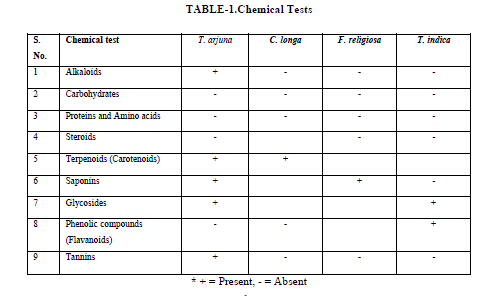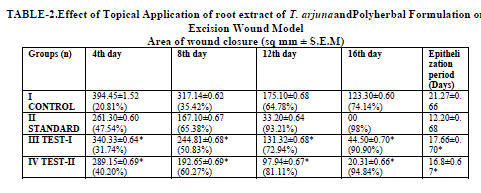ISSN ONLINE(2319-8753)PRINT(2347-6710)
ISSN ONLINE(2319-8753)PRINT(2347-6710)
M. Ismail Shareef1, P. Jagan Mohan Reddy1*, S. M. Gopinath1**, K. S. Dayananda1, Ajay
Mandal2,Purushotham K.M***
|
| Related article at Pubmed, Scholar Google |
Visit for more related articles at International Journal of Innovative Research in Science, Engineering and Technology
The present study was aim to investigate the possible effect of Terminaliaarjunaroot extract on wound healing and is also include a comparable study of effect of polyherbal formulation containing Terminaliaarjuna, Ficusreligiosa,Curcuma longa and Tamarindusindica, on wound healing process with respect to intact plant formulation through topical route. The wound healing property of Terminaliaarjunaappears to be due to the presence of its active principles,which accelerates the healing process and confers breaking strength to the healed wound. Further, wound healing activity by polyherbal formulation was found to be better than ageratum treated groups in rat. It may be attributed to the synergistic action of ageratum constituent and the constituent of other plants present in the polyherbal formulation
Keywords |
| Terminaliaarjuna, Wound Healing. |
INTRODUCTION |
| A wound may be defined as a break in the epithelial integrity of the skin or may also be defined as a loss or breaking of cellular and anatomic or functional continuity of living tissue.[1] Wound healing studies are mainly aim to detect various means and factor influencing healing process, so they could be either used or avoid in clinical practice to favorably alter the healing process.[2] Although many indigenous tribes around the world have long suspected that this ubiquitous, annual, herbaceous plant might have medicinal wound healing properties, it has not really got the attention of orthodox medical practitioners as a potential source of a healing agent which may prove to be useful in the treatment of wounds.[3]Terminaliaarjunabelonging to Combretaceaeis a common Plant found everywhere in India and commonly known as Arjuna. The leaves are applied to the wounds act as septic and heel them quickly. The juice of the fresh plant and extract of dried plant are used to cure allergic rhinitis and sinusitis.[4]Ficusreligiosabelonging to Moraceae is a large deciduous tree with few or no arial roots, often epireptic.It is found throughout India, wild as well as cultivated and commonly known sacred fig, pippal, pippalahetc.Bark, leaves, tender shoots, fruits, seeds and latex are used medicinally and are generally propagated by seeds and vegetative methods.[5]Curcuma longa belonging to zingiberaceae is a tufty perennial herb about 1 m. high. Rhizomes are thick,much branched, and golden-yellow in colour. Rhizome has anti-inflammatory and cholinergic properties. Also used as a pultice for wounds to avoid their cicatrisation.[6]Tamarindusindicabelonging to caesalpiniaceae is a large evergreen tree up to 30m high with dark grey bark having longitudinal fissures and deep cracks. Root bark is astringent, constipating, emmenagogue and tonic.Leaves are anti fungal anti-inflammatory, anthelmatic and diuretic.[7]The drugs selected for this work were Terminaliaarjuna, This is an important herb reported to have significant activities.[2,5,14] |
II. MATERIALS AND METHODS |
| The plants were selected on the bases of their antimicrobial activities and wide medicinal uses in the traditional literatures. The ease of availability of plant is also taken into consideration during selection. Roots of Terminaliaarjuna(Arjuna), rhizomes of Curcuma longa (Turmeric), stem-bark of Ficusreligiosa(Peepal) and leaves of Tamarindusindica(Tamarind) were collected from Bangalore region. |
 |
 |
| Extraction: Preparation of extract of various plant parts mentioned was done by maceration, using alcohol (Ethanol 95% v/v). Extracts after filtration were concentrated at low pressure by distillation and finally air-dried. Phytochemical studies: Collected extracts were subjected to various chemical tests for the preliminary determination of phytoconstituents. All extracts were mixed with equal proportion of alcohol and water (to get a hydro-alcoholic sample), before subjected to various chemical reagents. Formulation: After preparation of extract and phytochemical studies,the next step was to formulate a polyherbalpreparation.An ointment with water soluble base was of first choice due to their ease of preparation and also eases of cleaning after application.Polyethylene Glycol (PEG) Ointment base[8], a mixture of PEG 4000 and PEG 600 found to have sufficient consistency in ratio 3:7 respectively, thus suitable for ointment preparation with concentration of 10 % w/w of extracts.Two formulations were prepared by Fusion method e.g.one containing T. arjuna leaf extract (10% w/w) in PEG ointment base (Treated as main or TEST-I) and the otherone containing all four extracts of above mentioned plants parts in equal ratios i.e. containing 2.5% w/w of each extract, equal to total 10% w/w in PEG ointment base (Treated as polyherbal or TEST-II). The prepared formulations was then evaluated by various parameters e.g. consistency, stability etc. Wound healing activity: Excision wound model as described by Mukherjee P K.[9] with some modifications, using Albino rats was selected for assessing the wound healing activity. This model was employed to study the rate of wound contraction and the time required for full epithelization of the wounds.These parameters were selected because of easy availability of Albino rat and simplicity in handling them. Selection and procurement ofanimals: After taking permission for animal studies from Institutional Animals Ethics Committee, albino rats were procured and rats of either sex weighing 150-200 gm were selected,maintained at 24-280C, housed individually with free access to food and water. They were fed with standard diet and kept in well-ventilated animal house with alternate dark-light cycle of 12 hrs throughout the studies. Excision wound model: For the excision wound studies, twenty-four albino rats were taken, divided in four groups of six each. Rats depilated by removing hairs at the dorsal thoracic region before wounding. Rats were locally anaesthetized by xylocaine jelly (Lignocaine hydrochloride gel I.P., 2% w/v) prior to excision.Circular wound of about 2.5 cm diameter was made ondepilated dorsal thoracic region of rats under asepticconditions and were observed throughout the study. The areas of the wounds were measured (in sq. mm)immediately by placing a transparent polythene graphpaper over the wound and then tracing the area of thewound on it (Approx. area 500 sq mm). This was takenas the initial wound area reading.All the samples e.g. CONTROL (PEG ointment base),STANDARD (Soframycin), TEST-I (Terminaliaarjunaroot extract), and TEST-II (Polyherbalformulation), were applied once daily for 16 days,starting from the day of wounding. The observations ofpercentage wound closure were made on 4th, 8th, 12thand 16th, post wounding days. The wound area of eachanimal was measured at intervals of 24-48 hrsusingtracing paper method. The percentage of wound contraction was calculated from the days ofmeasurements of wound area.The wound contraction was calculated as percentagereduction in wound area with respect to initial woundarea while the epithelization time was noted as thenumber of days after wounding required for scar to falloff leaving no raw wound behind. |
| Statistical analysis: The results were analyzed by one-way ANOVA and a Pvalueless than 0.01 was considered significant. |
III. RESULT AND DISCUSSION |
| Phytochemical investigation of different extract showedthe presence of alkaloids, and tannins in T. Arjunasample only. Also no sample shows the presence ofproteins and amino acids. The details of qualitative chemical tests and phytoconstituents present in theextracts are shown in Table-I.In all formulations there was no considerable change in characters like color, odor, and consistency and therewas no phase separation observed during the course of study. Also, no patches on rat skin were observed during skin irritant test. No mortality was noticed amongst the animals in all thetreated groups. The cases of wound infection were also negligible and of mild severity in the groups.There was noticeable homogeneity in the woundcontraction observed for animals in the experimentalgroups compared with the control group. The end scarformed was a fine linear white scar that was visible onthe flank of the animals.The studies on excision wound healing model revealsthat all the four groups showed decreased wound areafrom day to day. However, on 16th post wounding day, Group-I animals showed 75.14% of healing (which maybe due to self immunity of the animals) where asSoframycin treated animals showed 100.00% healing.On the other hand, the Ageratum treated group showed90.90% of wound healing. Also, polyhebraltreated roup shows 95.94% healing (Table-II). All readings arefound to be statistically significant and comparable withcontrol.Theepithelisation time i.e. time at which complete scarformation occur, also suggest that both ageratum treatedgroup and polyhebral treated group were found to besignificant and comparable with control (Table-II).On the basis of the results obtained in the presentinvestigation, it is possible to conclude that the ointmentof the root extract of Terminaliaarjunahassignificant wound healing activity. The above findingsjustify the wound healing properties of the roots ofageratum as suggested in the traditional literatures wascomparable with control. It may be attributed toantimicrobial and haemostatic action of ageratum.The wound healing property of Terminaliaarjunaappears to be due to the presence of its active principles,which accelerates the healing process and confersbreaking strength to the healed wound.Further, wound healing activity by polyherbalformulation was found to be better than ageratum treatedgroup. It may be attributed to the synergistic action ofageratum constituent and the constituent of other plantspresent in the polyherbalformulation.Severalphytoconstituents like alkaloids[10] and saponins[11]are known to promote wound healing process due totheir antioxidant and antimicrobial activities. The studyreveals that both ageratum and polyherbal treated groupspossesses good wound healing properties which may beattributed to the individual or combined action ofphytoconstituents like alkaloids, saponins and terpenoidspresent in it[12]=[14]. Further investigations are necessary todetermine the bioactive constituents present in theextracts used for studies. |
References |
|